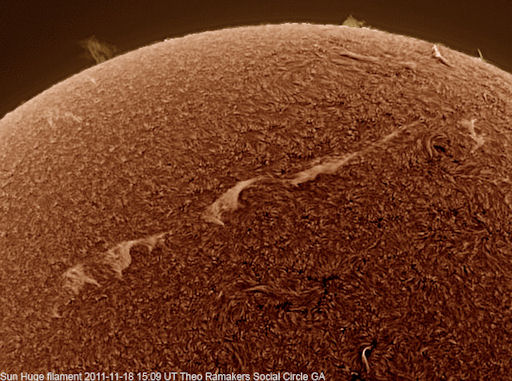~SPACE WEATHER UPDATE~ A HUGE NEW SUNSPOT MIGHT BE EMERGING, COMING AROUND~11~19~11~

Solar wind
speed: 307.4 km/sec
density: 0.1 protons/cm3
explanation | more data
Updated: Today at 0234 UT
X-ray Solar Flares
6-hr max: C4 2228 UT Nov19
24-hr: C4 2228 UT Nov19
explanation | more data
Updated: Today at: 2359 UT
![]()
Daily Sun: 20 Nov 11
A significant sunspot might be emerging at the circled location. Readers with solar telescopes should point their optics at the NE limb. Credit: SDO/HMI![]()
LEONID METEOR UPDATE: According to the International Meteor Organization, this year's Leonid meteor shower peaked on Nov. 18th with a maximum rate of ~18 meteors per hour. That's not many (especially compared to the Leonid storms of a decade ago), but sometimes just one Leonid can be enough. In Chelmsford, UK, astronomer Nick James caught this fireball lighting up the sky almost as brightly as the Moon:
Across the Atlantic in New Jersey, photographer Jeff Berke enjoyed a similar Leonid moment: "I saw a Leonid Fireball around 4:20am that lit up the sky creating shadows and a smoke trail which lasted close to 45 seconds. It was an incredible night!"
The shower is subsiding as Earth exits the debris stream of parent Comet Tempel-Tuttle. Tune into SpaceWeather Radio for farewell echoes.
more Leonids: from Peter Meadows of Chelmsford, Essex, UK; from Christopher Handler of Largs Bay, Adelaide, South Australia; from Jett Aguilar of Quezon City, Philippine; from Dr Salvador Aguirre of Hermosillo, Sonora, Mexico; from Sylvain Weiller of Saitn Remy lès Chevreuse, France
GREAT FILAMENT: It's one of the biggest things in the entire solar system. A dark filament of magnetism measuring more than 700,000 km from end to end is sprawled diagonally across the face of the sun. Amateur astronomer Theo Ramakers photographed the structure yesterday from Social Circle, Georgia:
"What a beautiful view," says Ramakers. "Wow--would I like to image this if/when it collapses! Can’t wait to see what tomorrow will bring."
Indeed, the future could bring some action. Filaments like these have a habit of collapsing, and when they fall to the stellar surface the impact can trigger a Hyder flare. Readers with solar telescopes are encouraged to monitor developments




